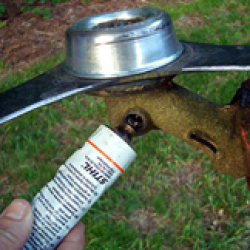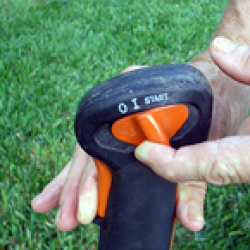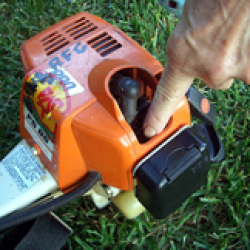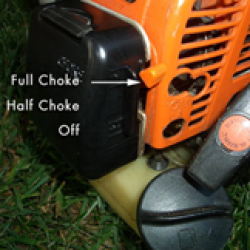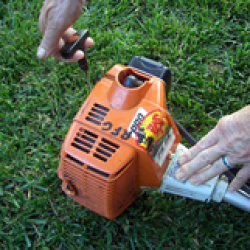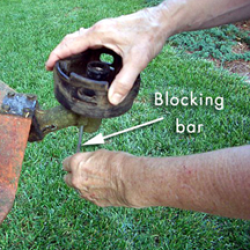Operating A Stihl Brush cutter

Most of us have used a weeder or a brush cutter before. However, we all need to stop and think about the tools and how we use them on and for our trail sections, and this is as good a time to do it as any.
Gasoline-powered brush cutters are a blessing for us. They let us really cut away the undergrowth and grass as we maintain our trail sections, and do it quickly and efficiently. My intent here is to remind us all of some basic safety factors as well as to describe some things to do when using one of our brush cutters.
Safety First, Last—Always
Safety is always Job #1 for us. Some of my thoughts about this are:
- Wear Protective Clothing.
- You should always wear a long-sleeved shirt, long pants, boots, and gloves as well as the protective helmet provided in the tools cache when cutting.
- Always remember those who are hiking your trail section!
- Hikers will try and pass you by as if you're a stationary obstacle—like a boulder in the trail or a blown-down tree—without regard to the power tool in your hands, the noise it emits, and the ear muffs covering your auditory sensory devices (ears).
- You will probably encounter Evil Doers—wasps, bees, hornets, and yellow jackets—at some time while you're using the brush cutter.
- The first indication you’ll have is that extremely unpleasant sensation when the stinger hits the skin.
- There's really only one thing to do: turn off the machine and run! If you're allergic to bee stings, you should always have first aid material in your kit, whether over-the-counter stuff or prescription medication (epinephrine) provided by your doctor.
- If you carry tobacco, as I do, take some, wet it, and place it over the stings, secured by a band-aid. It works for me.
- Although it’s not required, have a helper or companion with you when you're using the brush cutter.
- Your companion may, for instance, spot that timber rattler long before you'll hear it (especially when you're running the tool).
- He or she may also be able to tackle the hikers before they try to blow right by you.
- Always remember those who are hiking your trail section!
- Carry plenty of water as well as some snacks.
- Take as many breaks as you need—in fact, take more than you think you need.
- The helmet alone will cause you to lose water, profusely, through your sweat.
- And, the vibration from the brush cutter and the constant swinging motion you make as you cut will tire you out.
- A tired operator is an accident waiting to happen.
Always remember those who are hiking your trail section!
Before You Start
Please review the Operator’s Manual for the machine you use—each machine is different, and each is similar. I've described some of the tasks common to the Stihl brush cutters we use here.
Lubricate the Gear Head
Be sure to lube the gear head each time you use the machine, before starting the brush cutter. Take the scrench—the long combination screw driver-wrench—and remove the small nut on the gear head. Then, squeeze lubricant from the tube into the canal until no more will go inside. Then, screw in the small nut and tighten using the scrench.
Fuel the Machine
Fill the gas tank with 92 octane gasoline mixed with Stihl engine oil at a 50:1 ratio. You should find bottles of engine oil in the cache with the brush cutter and a gas container. Please re-fill the gas container with the 50:1 gas-engine oil mix after you finish using the machine.
Keep your receipt—send it to the Trails Coordinator for reimbursement.
Starting
A Stihl brush cutter can be a bit cranky when you try to start it. This may result from the fact that, through experience, they know what is about to befall them, but…be firm and patient, and you’ll be rewarded.
Set Control Switch
The Start switch is on the right-hand handlebar.
- Hold the trigger in (push).
- Move the switch to Start.
- Release the trigger.
- If the switch remains at Start, you're okay to go ahead.
- Otherwise, repeat—remember to continue to press the trigger while moving the switch!
Priming
Next, you must prime the carburetor. Push the clear plastic bubble on top above the air filter element. You may have to push it several times until you see liquid (that's gasoline) inside the reservoir.
Choking
Normally, choking is something we avoid, if possible. Many aren't used to thinking about the choke on a carburetor since, well, most of our autos today don't have carburetors. Even if yours does, you probably don’t have to work a choke. The 2-stroke engines on the Stihl brush cutters, however, have chokes. When you start them for the first time, move the choke lever on the carburetor from Off to Full Open (from bottom to top).
It Takes a Jerk…
(as we used to say in an infamous Boy Scout campfire skit)
- Grasp the bar of the brush cutter with one hand to hold it steady.
- Take the handle for the lanyard in your other hand.
- Pull up and out sharply.
- Try to not release the lanyard handle as the cord rewinds—If you do, it may strike you, and it won’t feel good when it does.
If the lanyard pulls out and away from the machine, store the equipment and notify the District Manager as soon as possible. We will have the brushcutter repaired.
Choke Down
- After you start the engine, you can either move the choke lever to Half Open or Off.
- You may need to run the machine with the choke set to Half Open.
Running the Machine
The 2-stroke engine is efficient but persnickety. It likes to be run at full throttle at all times. In fact, running it full-blast helps keep the carburetor and spark plug clean.
Changing Cutting Heads
The brush cutters have three cutting heads: a string trimmer, a Polycut, and a three-blade carbon-steel brush knife. The string trimmer is the head most of us are accustomed to use, since that's what works best with our lawns at home.
It works fine on the trail against grasses, but it may get jammed up by heavier weeds—the thicker stalks on weeds (such as stinging nettle) tend to shred and become embedded between the spindle and the trimmer head. This will stop and jam the head very quickly. In most cases, the Polycut head, with three plastic blades and a section of cutting string, works best on the trail. If, however, you have woody stuff to cut, such as mountain laurel, you may want to switch to the brush knife.
The brush knife works best on stinging nettle.
The brush knife will kick up shards of rock (a.k.a. "shrapnel") when you accidentally strike stone. Be sure to wear a long-sleeved shirt and long pants as well as the protective helmet (with the visor turned down) at all times!
Remove the Cutting Head
- Use the small locking bar to lock the cutting head in place.
- Slide the bar into the channel on the side of the gear head and turn the cutting head until the bar slips into place and the cutting head will not turn.
- Grasp the head with both hands and turn following the direction arrow on the head.
- Release the head by turning it in the clockwise direction.
Replace the Cutting Head
- Set the new cutting head over the spindle.
- Place the metal washer over the head.
- Set the metal cup over the washer.
- Set the locking nut on the spindle; hand-tighten.
- Using the scrench, tighten the locking nut.
- Turn the scrench counter-clockwise.
Clean the Tool
Please clean the tool before returning it to the tool cache. If you have an old, ragged Dobie pad that can't be used to wash dishes anymore, you can use it—with water—to clean off the "barrel" and the orange plastic guard around the cutting head. Check the air filter and knock off any debris that has collected there, too.
Contact the South District A.T. Manager for maintenance to the engine or cutting head requiring Stihl-certified service, cutting head supplies (thermo-plastic knives for the Polycut head, sharpening of the Brush Knife, lube oil for the cutting head, etc.), repair or replacement of the personal protective equipment (such as the helmet).
 South Shenandoah
South Shenandoah